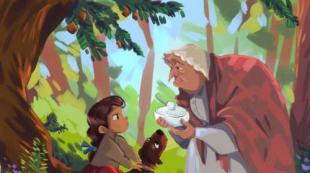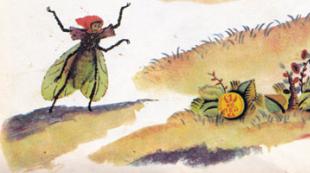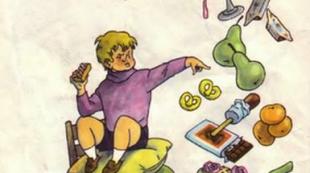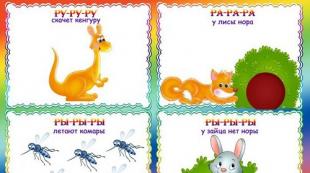The main characters and their characteristics of the fairy tale Thumbelina. Encyclopedia of fairy-tale heroes: "Thumbelina". One woman, a witch and a Thumbelina
Thumbelina
(artist S. Skop)
Thumbelina (Dat. Tommelise) is a tiny fairy-tale girl from the work of the same name by G.Kh. Andersen.
Appearance
The name Thumbelina was not chosen for the magical creature by chance, compare the Dutch word duim - "thumb". Thumbelina is indeed one inch tall, that is, approximately 2.5 cm. The girl was so tiny that she settled down to sleep in a nutshell, covered herself with a rose petal, and violet petals served as a mattress. A small plate of water seemed like a whole lake to Thumbelina. Beautiful, long-haired, with large expressive eyes, absolutely everyone liked the girl.
Personality and character
Good-natured and affable, Thumbelina trusted everyone who offered her help and temporary shelter, even a mouse that tried to marry her off to a wealthy, blind, greedy mole. The girl lives in her own world, very lonely, until the appearance of the flower elf. Thumbelina is merciful and kind: she nursed a swallow that had been injured on a thorn bush and was frozen.
Thumbelina loved and knew how to sing: "No one has ever heard such a gentle, beautiful voice".
Childhood

In the houses of the old mouse *
The girl grew out of a sorceress tulip, which bloomed on a childless woman right on the window. The mistress of the flower was very happy with the baby and did everything so that Thumbelina could live well and calmly: she made a bed in a nutshell, came up with simple entertainment. But one day, when the girl was sleeping on the table in her nutshell, a toad crept through the broken window. She admired the little beauty and decided to steal her. So the childhood of Thumbelina ended sadly, and life began with all its difficulties.
Wandering
The fish helped the girl to get rid of the toads. Seeing the lovely creature, they decided to help the girl and gnawed at the stem of the water lily. And when the leaf swam past the moth, Thumbelina tied her belt to it and swam away. Then the May beetle kidnapped her, then the girl spent the whole summer in the forest among the plants, hiding from the rain under a wide leaf. In the fall, she was sheltered by an old field mouse, which turned Thumbelina practically into her servant and almost gave the girl in marriage to a mole. Finally, the swallow, rescued by Thumbelina, took her to the southern country, and there the girl joined the flower elves.
Magic

In the land of the elves **
There is no special magic in Thumbelina. The only exception is being born from a magic flower. Otherwise, apart from her angelic voice and incredible diminutiveness, this is a completely ordinary child with a light character. But thanks to her meekness and mercy, the girl saw real magic - the fabulous land of flower elves, who gave her light wings.
Andersen G.H. Thumbelina (translated by L. Braude)
Andersen G.H. Thumbelina (translation by A. Vasilyeva)
Andersen G.H. Thumbelina (translated by P. Weinberg)
Andersen G.H. Thumbelina (translated by T. Gabbe)
Andersen G.H. Thumbelina (translated by T. Gabbe, A. Lyubarskaya)
Andersen G.H. Thumbelina (translation by A. Ganzen, with illustrations)
Andersen G.H. Thumbelina (translation by A. Hansen, T. Gabbe)
Andersen G.H. Thumbelina (translated by M. Hansen)
Andersen G.H. Thumbelina (translated by P. and A. Hansen)
Andersen G.H. Thumbelina (translation by I. Guseva)
Andersen G.H. Thumbelina (translation by O. Ivanova)
Andersen G.H. Thumbelina (translated by N. Konch, M. Melnichenko)
Andersen G.H. Thumbelina (translation by S. Kuzmin)
Andersen G.H. Thumbelina (translated by T. Kuzmina)
Andersen G.H. Thumbelina (translation by E. Lopatina)
Andersen G.H. Thumbelina (translated by M. Lyalina)
Andersen G.H. Thumbelina (translated by E. Pavlova)
Andersen G.H. Thumbelina (translated by M. Polievktova)
Andersen G.H. Thumbelina (translated by O. Rogova)
Andersen G.H. Thumbelina (translated by M. Tarlovsky)
Andersen G.H. Thumbelina (translation by G. Shalaeva)
Andersen G.H. Tiny (translation by A. Fedorov-Davydov)
Andersen G.H. Lizok with a Marigold (translation by V. Sablin)
Andersen G.H. Tommeliz (translated by S. Zaimovsky)
Audio versions
* Image source: http://www.liveinternet.ru/users/ketevan/post234832915/
** Image source: http://www.planetaskazok.ru/ghandersenskz/duimovochka?start=2
"Thumbelina" Andersen composed himself, although, of course, it is obvious that the great Danish storyteller drew inspiration from stories about a small people, and the Boy with a Thumb (Tom Thumb) is considered one of the most widespread European fairy tales. The tale was first published in December 1835 in Copenhagen, in the second volume of Fairy Tales Told for Children, and critics initially frowned upon it - too simple language was written "Thumbelina", and the lack of morality in those days when all the scarce children's literature had an edifying value, they were not pleased. And only one literary critic wrote that it is "the most delightful fairy tale you could wish for." But "Thumbelina" was very fond of children, it remains one of the most beloved by children of Andersen's fairy tales, along with "The Little Mermaid" and "The Snow Queen".
The plot of the tale is as follows: one woman did not have children, but she really wanted to, and then she went to the witch, who handed her a grain of barley. The woman planted a seed in a flower pot, and a beautiful tulip-like flower grew out of it. When the petals of the flower opened, there was a beautiful girl inside, so small that a walnut shell served as a cradle for her. Once a toad entered the house and kidnapped Thumbelina, deciding to marry her off to her son, but she managed to free herself. She lived the whole summer in the forest, and in the fall the poor thing was sheltered by an old field mouse, who also conceived of marrying her off, this time to a rich but extremely stingy mole. Fortunately, Thumbelina found and left the frozen swallow, which saved her from a hated marriage and took her to a warm southern country, where the little beauty met the king of the elves. He immediately fell in love with Thumbelina and offered her his hand and heart. So Thumbelina found happiness and a new name - from now on she was called Maia. And the swallow, returning to Denmark (Denmark), told her story to one person, "a great master of storytelling" - it is understood that it was Andersen himself.
In 1846, the tale was translated into English, and Russian readers met Thumbelina much later. The first Russian translation of the fairy tale was published in 1905, but the name of the tiny heroine of the fairy tale was then completely different - Lizok with vershok. Today the fairy tale has been translated into many languages, and in each translation Thumbelina bears its own name. In Danish it sounds like Tommelise, literally "An inch-sized fox"; in English Tambelina, from the word "thumb", i.e. "thumb on the hand"; in Czech - Malenka; in Bulgarian - Palechka; in French - Pucelina, from "pouce" or "thumb". As we can see, in almost all translations in the name of Thumbelina her growth is played up.
Although Thumbelina's modest size makes Thumbelina akin to Thumbelina, she completely lacks the entrepreneurial spirit characteristic of this hero. Everything that happens to Thumbelina happens to her by the will of fate and other characters. The toad kidnaps her, the fish are freed, the May beetle takes her to the forest, the field mouse saves her from cold and hunger, and the swallow takes her to warmth and love. The only thing that Thumbelina herself did was save, warmed and feed the bird, for which she was rewarded. So a certain morality can still be traced in the tale. Researchers believe that "Thumbelina" reflects the natural type of woman's behavior in the era when the fairy tale was written. Thumbelina is, without a doubt, a passive type, an unconditional victim of circumstances, and even in a happy ending, the king of the elves decides her fate.
The fairy tale became so popular that the cinema, animation and television that appeared in the 20th century simply could not pass it by. All over the world there are a huge number of cartoons and film adaptations that interpret this story in different ways. The very first film about Thumbelina appeared in 1924. It was dumb and black and white and would hardly impress today's children. The Soviet "Thumbelina" with a golden-haired heroine with huge eyelashes and a bright red skirt was released in 1964. 1994 featured a feature-length cartoon Thumbelina from Don Bluth Entertainment and Warner Bros. Family Entertainment; and the Japanese shot an anime cartoon in 1978 called Sekai Meisaku Dowa: Oyayubi Hime (World's Famous Children's Stories: The Thumb Princess). And this is just a small part of a huge list.
Like the fabulous Finger Boy, Thumbelina finds her adventures in life among our ordinary world - real people. The tale (like most of Andersen's tales) was invented by the author personally, and not borrowed "from the people." Together with the Ugly Duckling and some of Andersen's other characters, Thumbelina is an "outsider" character seeking her place in society. Such heroes evoke sympathy from the author.
The fairy tale "Thumbelina" is considered one of the most popular works of Andersen and is almost always included in the illustrated collections of his fairy tales. In addition, the fairy tale had its own interpretations in a large number of films, cartoons, children's plays, puppet shows, etc.
Thumbelina's story
Once, a woman grew a beautiful flower in her garden. Once, a woman kissed a bud, after which it burst and a tiny beautiful girl appeared in the flower. The woman named her Thumbelina, because the girl was no larger than a human finger and began to patronize her.
The girl was very pretty. This fact was once noticed by a frog. This frog imagines that Thumbelina can get married and be a wonderful couple for her son. To this end, the frog waits until midnight and steals the girl in order to deliver her to his son. The frog's son was fascinated by the girl's beauty. He placed Thumbelina on a water lily leaf so that she could not escape. Nevertheless, the girl finds help from the fish, which gnaw through the trunk of the lily, and the moth, who liked Thumbelina, harnessed to her belt and flew, pulling the leaf along the water. While the moth was pulling the leaf with Thumbelina, the girl was intercepted by the May beetle and carried her to him. The moth remained tied to the leaf. Thumbelina was very sorry for him - after all, he could not free himself and he was threatened with certain death.
The beetle brought Thumbelina to show his friends and acquaintances. But they did not like the girl, because the beetles had their own ideas about beauty. The beetle left the girl because he immediately stopped liking her. Poor Thumbelina remained to live in the forest. This is how she lived all summer. And as autumn came, the girl began to freeze. Fortunately, the frozen Thumbelina was found by a field mouse, which sheltered her in her burrow. Then, the mouse decided to marry the girl off to her rich neighbor Mole. The mole was very wealthy and, accordingly, stingy. But Thumbelina liked him, and he agreed to think about marriage. The Mole showed Thumbelina his underground "palaces" and wealth. In one of the galleries, the girl found a dead swallow. However, later it turned out that the swallow was just very weak. Thumbelina, secretly from the mouse and the mole, began to take care of her. Spring has come. The swallow recovered completely and, thanking Thumbelina, flew out of the mole's galleries.
At that time, the mole finally decided on the desire to marry. The mouse ordered the girl to sew a dowry for herself. Thumbelina was very sad and insulting, because she really did not want to marry the mole. The wedding day arrived. Thumbelina decided to go out for the last time and say goodbye to the sun. At that moment, the same swallow flew over the fields. The swallow takes Thumbelina with him to warm lands, saving her from the stingy and calculating mole.
Thumbelina (frame from the cartoon studio Enoki Films)
And now, Thumbelina is in warm lands. She takes up residence in the flower. She meets the king of the flower elves, who was as small as Thumbelina. Elf and Thumbelina immediately fell in love and became husband and wife. The king named her Maya, because he thought that the name "Thumbelina" was not good enough for a pretty girl like her. So Thumbelina-Maya became the queen of the elves.

Thumbelina (frame from the cartoon of the same name by Don Blat)
Screen adaptations and staging
Wikimedia Foundation. 2010.
See what "Thumbelina (character)" is in other dictionaries:
Thumbelina: Thumbelina is a character in the fairy tale of the same name by Hans Christian Andersen Thumbelina is a 1964 film made in the USSR? Thumbelina cartoon of 1964 production of the USSR Thumbelina cartoon of 1993 production of the USA Thumbelina film ... ... Wikipedia
Cm … Synonym dictionary
Story Mr Andersen"Thumbelina"
The main characters of the fairy tale "Thumbelina" and their characteristics:
- Thumbelina, a little girl from a tulip flower. Very beautiful and fragile. Everyone wanted to marry her against her will, but she married a beautiful elf, just like herself.
- The woman, Thumbelina's mother, is kind and quiet.
- Toad and her son. Scary and ugly
- Chafer. Important and self-confident.
- Harvest mouse. Kind old lady. who believed that Thumbelina was happy with a rich mole
- Mole, blind and narrow-minded, but very well-to-do. He did not like the sun and birds.
- The swallow, the bird that Thumbelina saved, kind and loyal, saved the girl from the mole
- The king of the elves, small and handsome with wings, fell in love with Thumbelina.
- The woman and the witch
- Beautiful flower
- Thumbelina
- Abduction by the toad
- Water lily in the middle of the river
- Fish help
- Butterfly
- Chafer
- Life in the forest
- Harvest mouse
- Swallow
- Spring
- Sewing a dowry
- Swallow again
- Marble palace
- Elf king
- Wedding.
- Thumbelina is born from a flower and lives with her mother
- Toad kidnaps Thumbelina, but fish help Thumbelina to escape
- The May beetle catches Thumbelina and introduces her to her relatives, but those do not like the girl.
- In the summer, Thumbelina lived in the forest, and in the winter she asked to live with a field mouse
- The mole wooes Thumbelina, and the girl saves the swallow, which in a year takes her to warm lands.
- Thumbelina meets the king of the elves and marries him.
Beauty is so fragile that it must be cherished and cherished. Don't let ugliness touch beauty.
What the fairy tale "Thumbelina" teaches:
This tale teaches us to believe in the best, to be kind and sympathetic, to help those who need our help. This tale teaches us that you can only love a worthy person, someone who will be a real couple.
Signs of a fairy tale:
- The magical birth of Thumbelina
- Magical creatures - elves
- Magical adventures and flying on a swallow
I really liked the fairy tale "Thumbelina". The main character of the tale is so fragile and defenseless, but at the same time very kind and fair. She did not lose heart, no matter what trials awaited her and was always submissive to fate. But her kind heart helped her find her happiness, because she found true friends.
Proverbs to the fairy tale "Thumbelina"
Do not be born beautiful, but be born happy.
You will not get to know your friend without trouble.
You can't be cute.
Summary, a short retelling of the fairy tale "Thumbelina"
One woman did not have children and she turned to the witch with a request for help. The witch gave the woman a magic grain of barley, and the woman gave the witch twelve coppers.
The woman planted the grain, watered it and it sprouted immediately. A beautiful flower bloomed, only with compressed petals. Then the woman kissed the flower and it opened, and inside was a tiny beautiful girl who was named Thumbelina.
Thumbelina slept in a nutshell and during the day she rolled on a petal on a plate of water.
One night a toad came and carried away the shell with Thumbelina. She wanted Thumbelina to marry her son.
The toad carried Thumbelina to a water lily in the middle of the river, and the girl cried very much when she discovered her position.
The fish took pity on Thumbelina and gnawed at the stem of the water lily, and the water lily swam down the river. Thumbelina tied a moth to a leaf and swam even faster. But then the May beetle flew in and took away Thumbelina. The beetle brought the girl to his tree and introduced her to other beetles. But the beetles did not like Thumbelina and the beetle lowered her onto the grass.
Thumbelina remained to live in the forest, making herself a bed under a burdock leaf.
But autumn came and the burdock dried up. Thumbelina became cold and she went to seek refuge for the winter.
She found a field mouse mink and the mouse sheltered her for the winter.
Once a neighbor, a rich mole, came to the mouse and, hearing Thumbelina singing, decided to marry her. He took Thumbelina and the mouse to his home. On the way, he showed the girl a dead swallow.
Thumbelina felt sorry for the swallow and she secretly sewed a blanket for the bird, and put down under it. Then she heard the swallow's heart beating. Soon the swallow regained consciousness and wanted to fly away. But it was winter and the swallow had to stay in the dungeon. Thumbelina carried her grains.
In the spring, the swallow invited Thumbelina to fly away with her, but the girl was sorry for the mouse and she refused.
All summer Thumbelina sewed the dowry for the wedding, and when autumn came the mole announced that the wedding would take place in four weeks.
On the wedding day, Thumbelina came out of the mink to say goodbye to the sun, and suddenly a swallow flew in. She again invited the girl to fly away with her to warm lands and Thumbelina happily agreed.
The swallow brought Thumbelina to a warm camp and planted it in a large white flower next to the marble palace, under the roof of which the swallow lived.
A little elf with wings and a crown was found in the flower, who immediately fell in love with Thumbelina. He invited the girl to marry him and Thumbelina agreed.
The elves cheerfully celebrated the wedding of their king and gave Thumbelina wings like a dragonfly. Elves began to call Thumbelina Maya.
Year of writing: 1835 Genre: story
Main characters: Thumbelina - a tiny girl, toad, mole, swallow
Plot: A tale about the fate of a little girl. About what trials have fallen to her lot. The baby was abducted by a green toad. She had to spend the night in the open air in winter. And also she almost married a mole. Thumbelina was saved by a swallow, and carried away to a distant happy country.
The main idea of the tale is that after many difficulties, happiness still comes.
Read a summary of the tale Thumbelina Andersen
The fairy tale "Thumbelina" was written by Hans Christian Andersen. It tells how one woman really wanted to have a child. Desperate, she went to some witch who took pity on the poor woman and gave her a magic seed. He had to be planted in the ground. The woman did just that: she put a seed in a flower pot, watered it, and soon a delicate flower appeared, which had the shape of a tulip. On its petal sat a tiny girl with long eyelashes. For her small stature, the girl was named Thumbelina.
It was a wonderful sunny warm weather. Thumbelina slept in a nutshell right on the windowsill, and the gentle wind gently fiddled with her curls. The girl was happy.
One night, a large green toad jumped into the open window while Thumbelina was sleeping sweetly. She grabbed a nutshell the girl was in and galloped into the swamp. Her loud croaking woke Thumbelina and she opened her eyes. Imagine her surprise when she realized that she was far from home, right on the water lily leaf. With wide eyes in horror, the girl looked at the toad, which croaked something to her.
Thumbelina realized that she wanted to marry her to her son, and this made her even more upset. She sat and cried, and the tears fell into the river. A fish that passed by volunteered to help the girl. She called for help from the hermit crab, which cut off the stem with its claws and Thumbelina swam. She threw her belt over the butterfly, and the water lily leaf swam even faster. The toad ran after him. She almost grabbed the girl, who at the last minute was picked up by a beautiful beetle with a large mustache. He took Thumbelina up a tree, and began to admire her beauty. But this did not last long, since the other beetles did not like the girl. Everyone laughed at her, and the kind beetle that had just showered her with compliments immediately changed his mind. He apologized to Thumbelina and lowered her to the ground.
All summer the girl lived in nature. She wove herself a small bed of leaves and blades of grass. In the rain, she covered herself with a leaf of burdock, and in clear weather she basked in the sun.
Summer ended, and it was replaced by a cold autumn with frequent showers and cold winds. And then winter came altogether. The girl literally died of cold and without food. One day she came across a big mouse hole and knocked on the door. The mouse turned out to be compassionate, and immediately let Thumbelina into the house. The girl ate half of the grain and immediately felt better. The field mouse liked that the girl eats little, and she left her with her. There was a blind mole in the neighborhood. He was a recluse and did not like sunlight. All his occupation boiled down to the fact that he was constantly counting his wealth. Once a brilliant idea came to mind of a mouse: she decided to marry Thumbelina to a mole. The girl resisted with all her might. Once walking through the underground possessions of the mole, she saw a large dead bird. She lay on the cold ground, and did not move. It was a swallow. The girl gently stroked the belly of a large bird, and suddenly heard that her heart was beating.
Thumbelina formed and immediately slipped several last year's leaves under it, and also covered it from above. All winter, the kind girl looked after the sick bird, and when spring came, the swallow got stronger and flew away. In parting, she thanked Thumbelina from the bottom of her heart.
Meanwhile, the persistent mouse was getting ready for the wedding. When Thumbelina had nothing left to do but to agree, she asked to let her go to admire the sun. The mole and the mouse were surprised at the strange request of the girl, but nevertheless agreed.
Thumbelina was saying goodbye to the sunlight, when she suddenly heard someone calling her. It was again a swallow. She flew to warm lands, and Thumbelina decided to fly with her. She sat on the back of the cute swallow, and they flew.
The field mouse ran out to see where Thumbelina was, and was extremely surprised to see that the girl flew away. They flew over forests and seas, and eventually flew to some magical land. A beautiful elf flew out of the flower to meet her, and immediately captured the heart of the charming Thumbelina.
Picture or drawing Thumbelina
Other retellings and reviews for the reader's diary
- Summary of Bazhov Silver Hoof
The action takes place in the old days in one Ural factory settlement. The main characters of the work are Kokovan's grandfather, the girl Daryonka, the cat Muryonka and the forest goat.
- Summary Man in Chekhov's Case
The protagonist of the story, Belikov, is a teacher of the ancient Greek language in a gymnasium. His image is collective, typical for society. In the character and appearance of the protagonist, all the features of appearance are most pronounced
- Summary of Remarque Spark of Life
In his novel Spark of Life, Remarque describes the appalling conditions of prisoners in concentration camps. Great amount people of different nationalities and different destinies, behave differently when in inhuman conditions of life
- Summary of Menander the Grouch
The play takes place in a poor rural area in Attica. The ground here is rocky, and therefore barren. In the prologue to the play, God Pan leaves his sanctuary
- Summary of Captain Blood Sabatini's Odyssey
A bachelor of medicine has settled in the town of Bridgewater. His name was Peter Blood. Originally from Somersetshire, the son of a doctor, he spent a third of his life in Holland, where he served in the navy, spent two years in a Spanish prison









